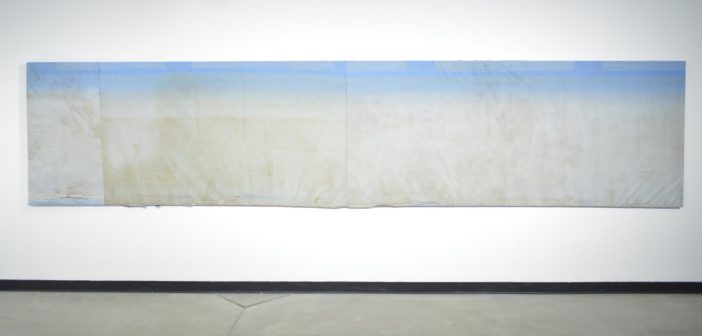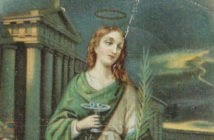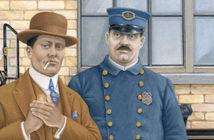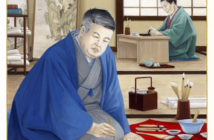Inside/Out is Big Red & Shiny's artist-in-residence series, offering a space for artists to write about their ideas, research, and challenges, and publish their inspirations, obsessions, creative experiences, and insights. Unlike an 'Open Studio' format, which is often predicated on potential sales, BR&S wants to provide the artist-in-residence with an outlet to place their practice in a more public realm, offering an expanded look at the creative process and placing emphasis on the time ideas and works take to mature. It is not expected that the artist produces anything finished or specific to BR&S in this time, only that they candidly share their explorations.
We are happy to welcome Ross Normandin to Inside/Out as our newest artist-in-residence. Working with materials as varied as cast rubber, steel, balloons, and the vinyl linings of swimming pools, Normandin’s art merges Minimalist qualities of seriality and austerity with an element of the absurd. He has said that in his work he attempts to create an environment “where your laugh exists in the same space as disgust.” There is something comical about the way his silicone knots and pig snouts emerge from a sheet of acrylic that, when coupled with the work’s pale fleshy tones and textures, becomes oddly unsettling—a combination that can also be found in a series of cast rubber renderings of the artist’s own head. In his first post, Normandin introduces us to his work and further elaborates on the qualities that lead us from amusement to discomfort and back again. —Scout Hutchinson, Editorial Assistant
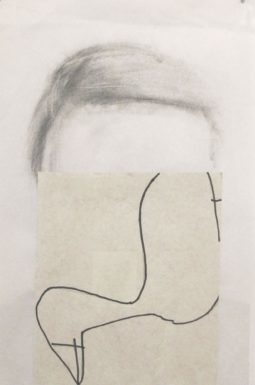
Ross Normandin. "Quack." 2014. Marker, graphite, inkjet on newsprint. 13 x 9”. Courtesy the artist and GRIN.
I recently exhibited at Rhode Island College and before most people had seen my work in the gallery, I spoke in a lecture hall. I chose to not talk about what was actually in the gallery since most hadn’t seen it anyway. More specifically, I chose to not talk about the relationship between the artworks and the space they were in. I felt like if I did, I would have had some influence on the viewer’s experience. I figured the listeners could connect the dots through my thoughts on past work with what was in the adjacent gallery space. I chose the regular routine except for perhaps the final image. I stood at a podium, clicked through a powerpoint, and tried not to be too nervous. It takes a few minutes before I can calm down. Then I shoot from the hip.
The first image was a work from 2014 titled Quack. The second to last image was a work from 2016 titled Pig. The final image was of myself sun bathing on a black rubber roof in Providence the day after my mother’s death. It was projected onto the screen for about a second before I ended the slideshow and asked if there were questions.
Quack is a small graphite and marker drawing on a faint inkjet print on newsprint. It depicts a head of hair with a cartoon duck over the face. Pig is a cast urethane and silicone rubber slab painting. The snout of a pig projects outward and a knotted “cord” hangs on top of and through the surface. I am a 5’5” shirtless man stretched out on a vinyl swimming pool liner that’s weighted down by potted plants and dumbbells on June 4th, 2015.
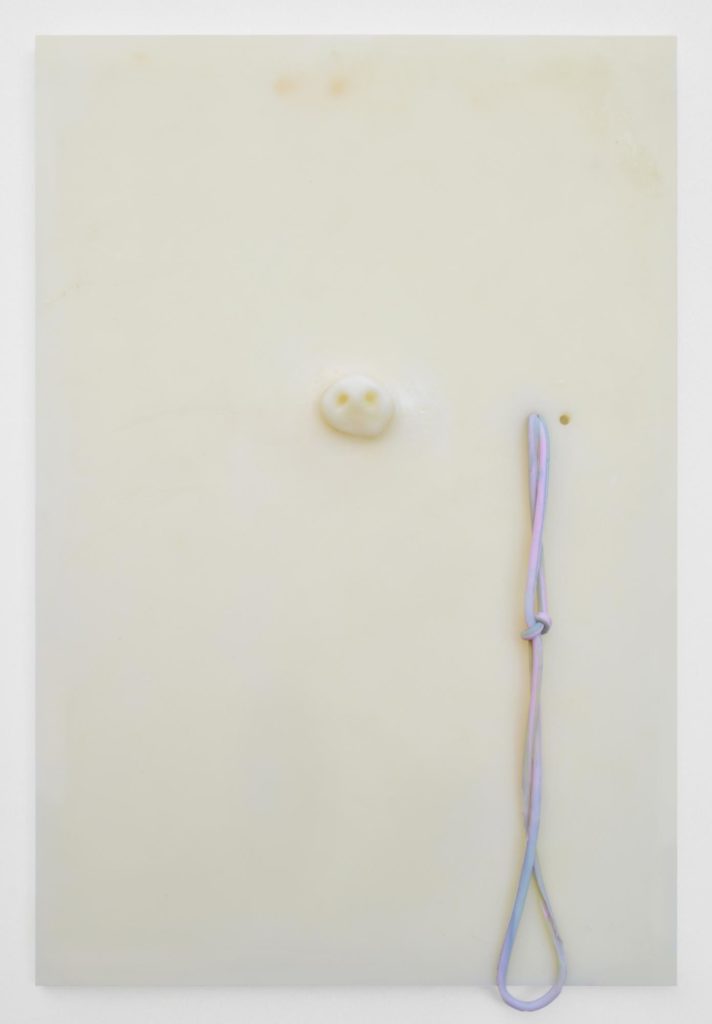
Ross Normandin. "Pig." 2016. Silicone and urethane rubber. 25 x 17 x 2”. Couresty the artist and GRIN.
I decided to add this image of myself sunning, which is so rare it’s absurd, as a bookend to a series of images of cast rubber masks (Short Holiday), naval/anus paintings (Wins, Crashes), a roll cage from a race car (Cage), and swimming pool liners stretched directly into paintings (Under Sun, Over Time) because I see my work, even though austere at times, as awkwardly humorous and lighthearted even in the bleakest of circumstances.
My attempt to absorb as much vitamin D as I could on that hot roof for happiness and sanity’s sake may have not worked, but at least there was someone with me behind the camera. Similarly, I think about art objects as companions, whether they’re the ones I make or the ones I see. I may channel much of my own life into my work, but I intend to make objects that reach others. I am reaching not with the intention of caring for or in the interest in others, but out of the necessity to.
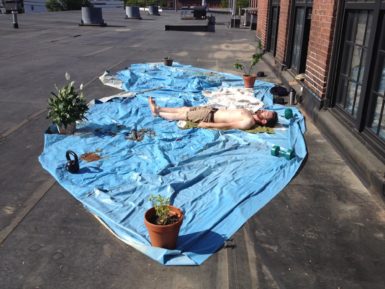 Short Holiday is a series that reflects a challenge and an urgency to eliminate the care of whom the artist might be. I decided to cast my face and produce death masks because I wanted to make something that was directly referencing the maker, but with the intention of turning the tables during the viewing experience. Ultimately, the function of the object was much more interesting than what the mask looked like. A mask is an object that’s worn by both you and me.
Short Holiday is a series that reflects a challenge and an urgency to eliminate the care of whom the artist might be. I decided to cast my face and produce death masks because I wanted to make something that was directly referencing the maker, but with the intention of turning the tables during the viewing experience. Ultimately, the function of the object was much more interesting than what the mask looked like. A mask is an object that’s worn by both you and me.
The last question asked that night at Rhode Island College was from someone who wanted me to go more in depth on Pig. After sharing my thoughts on Malice by Bruce Nauman, the processes of mold making/casting and the implication of making art that way, I answered, “you don’t ever want to be a quack or a pig, but sometimes you can’t help it.”
I didn't expect to say that. I don't know what to expect during this residency with BR&S, but thank you for being here.
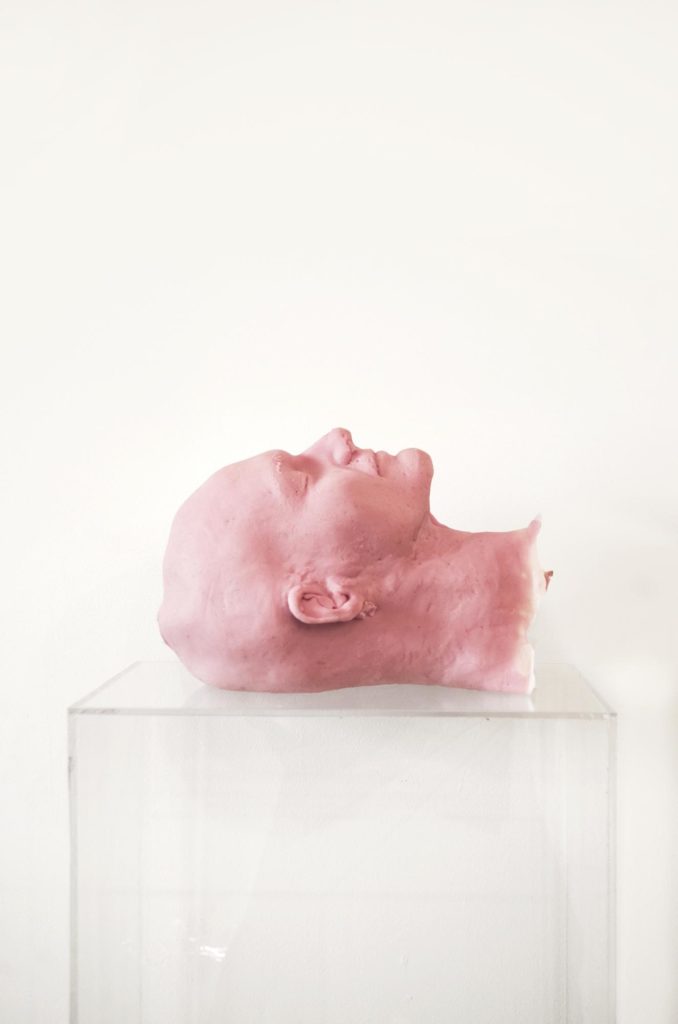
Ross Normandin. "Short Holiday." 2016, Silicone rubber, acrylic glass. Dims variable. Courtesy the artist and GRIN.

